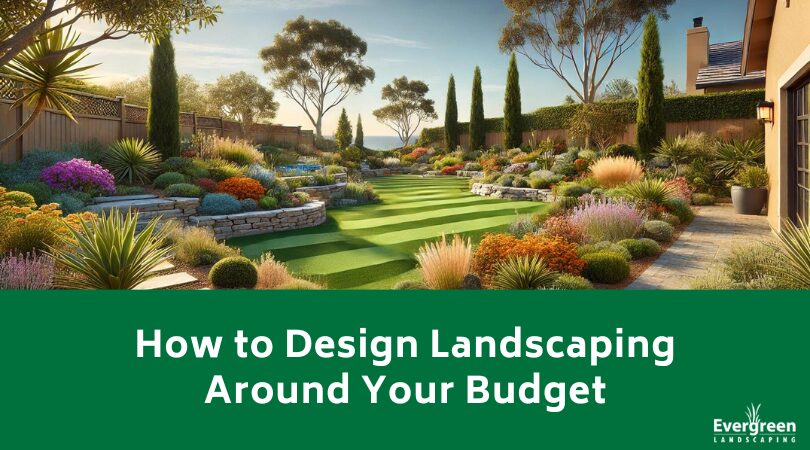
Designing a beautiful landscape that aligns with your budget can be challenging, but with careful planning and prioritization, you can create an outdoor space that fits your needs and finances. The key is understanding which elements are foundational, what should be installed first, and which aspects can be added over time. This guide will walk you through designing your landscape, starting from the most expensive and essential components to the more decorative and affordable options.
1. Hardscapes (Most Expensive & Foundational)
Why Install First:
Hardscapes form the backbone of your landscape and are typically the most expensive components. This includes patios, walkways, retaining walls, driveways, and any structural elements that require excavation, leveling, and professional installation. These elements not only define the flow and usability of your outdoor space but also require foundational work like drainage and leveling that can’t easily be adjusted after other features are in place.
- Examples: Pavers, stone pathways, concrete patios, and retaining walls.
- Tip: Choose materials that fit both your aesthetic and maintenance preferences. For example, natural stone is beautiful but pricier, while concrete pavers can be a more budget-friendly option.
Estimated Costs:
Hardscapes can range from a few thousand dollars for a small patio or walkway to tens of thousands for larger projects like driveways or retaining walls.
2. Synthetic Lawn
Why Install Second:
If you’re opting for a synthetic lawn, it’s another major expense that should be installed early in the process. Synthetic turf is an excellent choice in areas like Central Coast California, where water conservation is crucial. Installation involves laying down a base material and ensuring proper drainage, so it needs to be done before planting trees, shrubs, or other softscapes.
- Advantages: Requires minimal maintenance, conserves water, and provides a year-round lush appearance.
- Tip: If you’re on a tight budget, consider installing synthetic turf in smaller, high-use areas like front lawns or around patios, while leaving other areas for low-maintenance plants or groundcover.
Estimated Costs:
The cost of synthetic lawns can range from $8 to $15 per square foot, depending on the quality of the turf and installation.
3. Water Features
Why Install Early:
Water features like fountains, ponds, or small waterfalls should be installed early because they often require excavation and plumbing. Proper installation is crucial for both functionality and avoiding water damage to other landscape elements. Installing water features before trees, shrubs, and other softscapes ensures that these foundational components are well-integrated into the overall design.
- Examples: Small fountains, garden ponds, and modern water walls.
- Tip: To save on costs, opt for pre-fabricated water features rather than custom-built ones.
Estimated Costs:
Simple water features can range from $500 to $3,000, while more elaborate setups like large ponds or waterfalls can cost significantly more.
4. Trees, Shrubs, and Hedges
Why Install Midway:
Once the hardscapes and synthetic lawn are in place, it’s time to add trees, shrubs, and hedges. These larger plants help define the space, provide shade, privacy, and add structure to your landscape. Trees should be planted early because they require time to grow and establish themselves. Shrubs and hedges are also essential for creating privacy screens or natural borders around your property.
- Examples: Drought-tolerant trees like California sycamore or coast live oak, shrubs like lavender or rosemary, and hedges like boxwood or privet.
- Tip: Choose native or drought-resistant plants to reduce water usage and maintenance in the long run.
Estimated Costs:
Trees can range from $100 to $1,000 depending on size and species. Shrubs and hedges are generally more affordable, with costs around $20 to $200 per plant.
5. Plants and Groundcover
Why Install Next:
With the larger elements in place, you can now focus on smaller plants and groundcover. These plants are often less expensive and can be added in phases, making them ideal for homeowners working with a limited budget. Groundcover like creeping thyme or ice plant can fill in spaces around walkways or under trees, helping to reduce maintenance and water needs.
- Examples: Perennials like daylilies or salvia, and groundcovers like creeping Jenny or vinca minor.
- Tip: Use groundcover strategically in areas where grass or synthetic turf isn’t practical to create a cohesive look while reducing maintenance.
Estimated Costs:
Plants and groundcover are some of the most affordable landscaping elements, typically ranging from $5 to $50 per plant, depending on the species.
6. Flowers (Least Expensive)
Why Install Last:
Flowers are the final touch that adds color and vibrancy to your landscape. Since they are often the most affordable element, they can be added last without significantly impacting your budget. Annuals and perennials can be swapped out seasonally for a fresh look, making flowers a flexible and cost-effective option for adding visual interest.
- Examples: Marigolds, petunias, and dahlias for seasonal color.
- Tip: Mix perennials with annuals to ensure year-round blooms while keeping costs low. Consider planting flowers around pathways or in garden beds to create focal points.
Estimated Costs:
Flowers are typically the least expensive aspect of landscaping, with costs ranging from $2 to $10 per plant.
Designing a landscape around your budget is all about prioritizing the foundational elements and adding more decorative features over time. By installing hardscapes and synthetic lawns first, followed by trees, shrubs, and groundcover, you create a structured and cohesive outdoor space. Flowers and smaller plants can be added as finishing touches to enhance the beauty of your yard.
Contact Evergreen Landscaping today for a free consultation or quote, and let us help you design a beautiful landscape that fits your budget.
